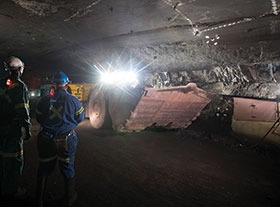

The application of very low frequency (VLF) technology in the development of underground safety equipment is an important step towards achieving the mining sector’s objective of zero harm, according to Booyco Electronics engineer and developer, Frank Schommer.
Booyco Electronics began developing collision warning systems over 12 years ago, using VLF technology to build a proximity detection system (PDS) for underground mines and becoming a pioneer in this complex field. “VLF,” says Schommer, “is used to generate a magnetic field around a vehicle, essentially a ‘fence’ that is independent of the material present in the immediate vicinity.
“In other words, VLF technology allows this magnetic field to travel through obstacles like rock and water, maintaining the fence at a constant distance from the vehicle. This means that the shape of the field around the vehicle remains exactly the same, whether the vehicle is underground or on surface.”
Due to their frequency, the waves are not reflected by walls or other elements of the environment, rather they penetrate these objects. What is vital is that the corners and crossings in an underground haulage have no effect on the shape and size of the magnetic field around the vehicle, as the waves will penetrate the rock walls and other obstructions that limit what operators and pedestrians can see.
“If the pedestrian is behind another vehicle, for example, or behind a corner in the tunnel, the proximity detection system must be able to pick up and pinpoint their position,” explains Schommer. “This is what VLF allows us to accomplish so effectively with our PDS solution.”
However, despite the advantageous characteristics of VLF waves, it is still a challenging process to create a magnetic field to the exacting specifications demanded by safety applications. It requires high levels of power in the transmission antenna to generate the field, for instance, and even in the receiver as well.
Schommer emphasises that PDS, when applied in the sphere of worker safety underground, must ensure absolute stability of conditions so that the performance of the technology can always be relied upon to operate optimally.
“That is the reason why we have used VLF technology as a basis for our solutions,” he adds, “as these waves are best able to deal with the reflective environment in underground workings and maintain fields of a constant size or distance from the source.”
Booyco Electronics’ innovations have leveraged VLF technology to provide valuable functionality for mine safety initiatives. Among the most important of these is the creation of detection zones within the magnetic field around a vehicle, which trigger specific operator warnings and subsequent actions.
“Our technology allows us to define the accuracy of these zones to within very low deviation tolerances,” says Schommer. “For instance, our first zone of safety may be 20 metres from the moving vehicle, and this is accurate to within 10 centimetres.”
When a miner – equipped with a VLF receiver and buzzer unit – enters this zone, the system sends a warning through a flashing light and a buzzer, to warn them that they are entering a dangerous area. Importantly, the behaviour of the VLF waves will allow the miner to be alerted even if they are behind a corner or otherwise out of sight of the vehicle operator, when within the detection range.
A second zone, closer to the vehicle, is also set up in the PDS to warn the vehicle operator that there is a pedestrian in the proximity. If the pedestrian does not respond to the warnings and gets even closer, they will enter a third zone which could now trigger mechanical intervention, for instance, switching the vehicle automatically to creep mode.
Should the pedestrian enter the last zone defined by the PDS – even closer to the vehicle – then a second intervention comes into play, stopping the machine in its tracks to avoid any possible collision or injury.
For more information contact Anton Lourens, Booyco Electronics, 086 126 6926, [email protected], www.booyco-electronics.co.za

© Technews Publishing (Pty) Ltd | All Rights Reserved